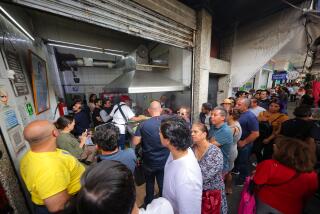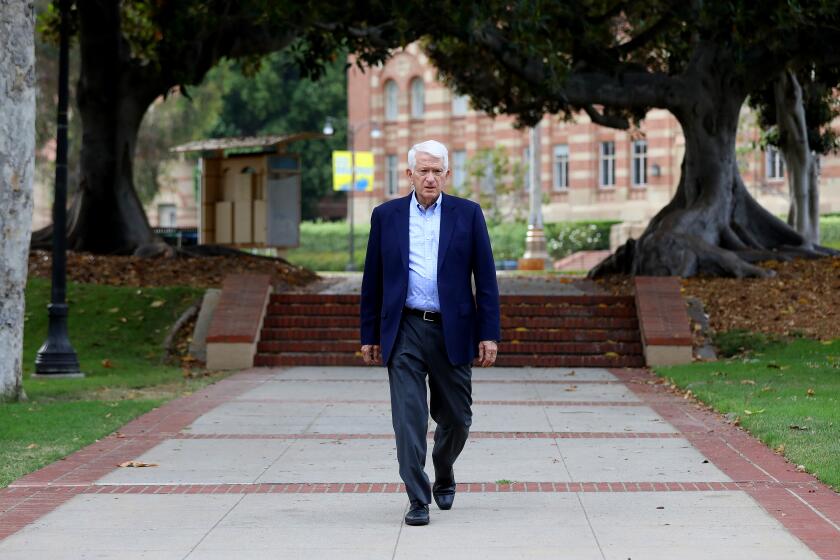Memories Still Flourish on a Quiet English Farm
The wind is bitter and icy as it whips a spray of light rain across the weathered concrete strip that gently dips and rises over David and Beth Alston’s wheat fields.
The weather turns hard here during certain seasons, with near-freezing temperatures and twilight by 3:30 in the afternoon. And standing in the middle of the long gray ribbon, watching it stretch off toward the green hills as the clouds lower and the elms swish and bend in the wind, is a lonely errand.
But the Alstons remember other cold days 43 years ago, when their farm was anything but lonely, when the damp air thrummed with the sound of dozens of huge engines, when the night was filled with the whine of winches and the shouts of young men picking their way back to their huts in the dark.
They remember the strange nasal accents of the men from Alabama and Wisconsin and California and New York who sat around their fire at night and flew off the next day to try to cheat death one more time.
Return Visits
Today those young men, now grown old, remember, too. Each year many of them return to the Alstons’ farm to sit around the fire once again and to stand on the runway to which they so gratefully returned from flying terrifying bombing missions over Nazi-occupied Europe.
Beginning in the Christmas season of 1943, the farm became the headquarters of the 487th Bomb Group of the U.S. Eighth Air Force. During the course of World War II, hundreds of American airmen, ground crewmen, technicians and others made the base, just outside the village of Lavenham in Suffolk county, their home. Many of them engaged in the fiercest air battles of the war. Many died in the thin air over Europe.
But many of those who survived to go home are, decades later, returning in increasing numbers to Lavenham and dozens of other East Anglia villages and towns where their memories of that turbulent time endure.
They arrive individually or as part of a tour, often arranged by veterans’ organizations, to look for the tiny Nissen huts in which they lived, the pubs where they drank and the English people who befriended them.
But while the pubs and some of the people often are still here, traces of most of the bases have disappeared. With the end of the war, most of the heavy bomber bases in East Anglia--as well as the smaller fighter bases--were deactivated, their buildings torn down, their runways and perimeter tracks ripped up.
Back to Farmland
In most cases, what had once been a bustling home for dozens of B-17 Flying Fortresses or B-24 Liberator bombers reverted to farmland. Local memories faded and many of the bases were all but forgotten.
But over the more than 40 years since the young Americans took over their farm, the Alstons have not forgotten. Through careful attention and diligent caretaking, they have preserved many of the base buildings much as they were during the war years.
Throughout the 500-acre farm are weathered Nissen huts, small sheds where parachutes once were packed, officers’ barracks and a stone structure that housed a Link trainer. And standing silent by the still-intact main runway is the base control tower, empty but well-preserved.
Because of the Alstons’ efforts, the former home of the 487th Bomb Group is considered the best-preserved heavy bomber base in England.
“We have very happy memories of that time,” Beth said. “And we feel we have a duty to take care of it, to keep the memories alive. Perhaps duty sounds too strong--it’s really a pleasure, not a hardship at all. We want the place to look civilized when the boys come back to see it. We don’t want them to be ashamed of it.”
The Alstons’ house, they said, was one of two gathering places for many of the airmen. The other was the Swan, a pub on High Street in Lavenham. The ancient, half-timbered Swan is a Trusthouse Forte hotel now, but the pub within remains, as do dozens of signatures and drawings on its wall made by base crewmen.
The most direct route to the Swan, remembered David Alston, was a rough-hewn path through the bracken on the base that came to be known among crewmen as the Burma Road.
“It was overgrown with thorn bushes and brambles and all that sort of thing, and it would always be littered with fallen bicycles,” Alston said. “The men would say, ‘I can find my way to the Swan, but I’ll be damned if I can find my way back again.’ ”
The Alstons’ memories for faces and airplanes have remained sharp. They smile when they recall bombers named “Mountain Time” and “Lumbering Lizzie” and an airman who returned from a trip to Scotland with a respectably authentic Scots accent.
“We started calling him MacSchwartz,” David said.
They Get Letters
Correspondence from the former fliers sometimes can be voluminous, especially before a veterans’ group plans a trip to England, said Beth.
“There’s a tremendous amount of correspondence, really a steady stream in the summer,” she said. “I do try to reply to them all because I feel they want to keep in contact with the base. It was a very, very important period in their lives.”
And the visits to the base near Lavenham--and other base sites in various stages of preservation throughout East Anglia--may be on the increase.
“A lot of them (veterans) have dreamed about it and some of them have saved for half their lives to come here,” said Ron MacKay, a member of Friends of the Eighth, a British historical organization for those with a particular interest in the U.S. Eighth Air Force of World War II.
MacKay and many of his colleagues offer returning veterans information and help in organizing visits. Often the veterans and members of Friends of the Eighth will collaborate with the Eighth Air Force Historical Society, (P.O. Box 3556, Hollywood, Fla. 33083) in helping to organize tours or individual visits.
“We’re approached pretty regularly for help,” said MacKay. “We brought over 400 people in 1976. These days, more of them may be coming because I think it’s a stage of their lives they’re reaching.
Still ‘Our Boys’
“Many of them are retired and that gives them a chance to indulge themselves in a trip like this. Sometimes they come back to a place that isn’t there anymore, but I’ve hardly ever seen one who wasn’t glad he came. It was such a strong bond for them.”
Though the airmen who return may be in their 60s or 70s, said Beth, “we still think of them as our boys. (The Alstons are in their 70s.) We have just the warmest, warmest feelings for them. And for them the visit can be very emotional, something that maybe they’ve looked forward to since they left back in the 1940s.
“It’s marvelous for the boys to be able to come back and see us, people who can talk to them about what happened here--to just sit here in the house by the fire and talk.”
More to Read
Start your day right
Sign up for Essential California for news, features and recommendations from the L.A. Times and beyond in your inbox six days a week.
You may occasionally receive promotional content from the Los Angeles Times.






